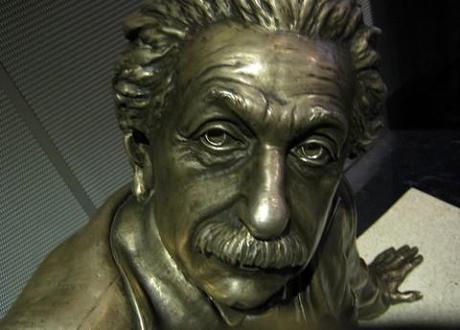
A statue of Albert Einstein. Could he have been wrong? Photocredit: ricardodiaz11 http://www.flickr.com/photos/ricardodiaz/2424064723/sizes/m/in/photostream/
The entire universe may about to be shaken to its very foundations. We may soon be able to take ship for the eighteenth century, or send emails to our ancestors. And why? Because of the humble neutrino. Neutrinos are terribly mysterious particles: they have no electric charge and no mass. And now scientists claim that they have measured neutrinos travelling faster than light – a speed which hitherto has been seen as a “cosmic constant”, and which underlines Einstein’s theory of relativity.
The Gran Sasso facility in Italy, and specifically Opera (Oscillation Project with Emulsion-tRacking Apparatus) has seen neutrinos travelling the whopping amount of a sixty billionth of a second faster than light. This is absolutely forbidden by Einstein’s theory of special relativity. It has been predicted before, though – in 1985, scientists claimed that neutrinos might be able to travel faster than light if they interacted with an “unknown field that lurks in the vacuum,” according to The Guardian. If it’s true – and that’s a very big if – it might mean a grand theory that brings together gravity and quantum mechanics.
The scientists at Gran Sasso sent some neutrinos on a 730 kilometre journey through the Earth, which would take a beam of light 2.4 milliseconds to complete; but neutrinos apparently took a shorter time to complete the run. They would have been travelling at 299,798,454 metres per second, as opposed to the speed of light, which, as everyone knows, is 299,792,458 metres per second. The statistical likelihood of such an event occurring is six standard deviations, which means that the discovery can be claimed (it has to be more than five standard deviations to count as an actual, proper, copper-bottomed discovery.)
This sort of thing rocks the foundations of physics. But should we be worried? The error margin is plus or minus 10 billionths of a second, and Susan Cartwright, a lecturer in particle astrophysics at Sheffield University, was quoted on The Guardian: “Neutrino experimental results are not historically all that reliable, so the words ‘don’t hold your breath’ do spring to mind.” Another scientist, Heinrich Paes at Dortmund University, says that actually the neutrinos might be “taking a shortcut through space-time” by going through “extra dimensions.” In which case, well, the discovery’s not so hot.
To be fair to the physicists, they’re waiting for their results to be confirmed. But this could shake everything: as Subir Sarkar, head of particle theory at Oxford University said: “The constancy of the speed of light essentially underpins our understanding of space and time and causality, which is the fact that cause comes before effect. Cause cannot come after effect and that is absolutely fundamental to our construction of the physical universe. If we don’t have causality, we are buggered.” “Meanwhile, in America, we’ve managed to perfect the technology to measure the speed of pizza,” said Gawker.
“It would turn everything on its head. It is too awful to think about,”
Professor Jenny Thomas of University College London told The Daily Telegraph.
In your face, Einstein! Nick Collins on The Daily Telegraph said that Einstein’s theory of special relativity was essential in understanding particle accelerators, and that if this was true, Einstein’s equation (E=mc2) would turn out to be wrong. He added that the results were being checked thoroughly by a laboratory in Chicago, where an experiment called Minos will be able to deliver results accurate to one nanosecond.
Or not? The Wall Street Journal was a little sceptical, saying that if the results are confirmed, it won’t really change the way we live: neutrinos “have presumably been speed demons for billions of years.” But it will change the way we understand the universe.
“Until this is verified by another group, it’s flying carpets. It’s cool, but …”, Drew Baden, chairman of the physics department at the University of Maryland told the Associated Press.
“Wow! There goes one – did you see that?” said Prof TK Max announcing the findings. “No? OK, you’ve got to be really sharp and don’t blink. There! See that?” said The Spoof.
Are you sure you checked? Well, said Cinemablend, if it’s true, then we’ll have to rewrite all the textbooks. If it isn’t, then “the guy who accidentally put the decimal point in the wrong place is really going to hear about it.”
Hold your neutrinos. A well-balanced article by Clay Dillow on Popsci said there was no need to throw away the textbooks. What the physicists were doing was testing the frequency of oscillations (where one “flavour” of neutrino changes to another). So they were sending “muon” neutrinos to Gran Sasso, and seeing how many ended up as “tau” neutrinos. 15,000 “batches” of neutrinos have thus far been measured over that distance, and the experimenters now say that the statistical anomaly is great enough to be significant. But they still want outside verification, and so we’ll have to wait and see.

